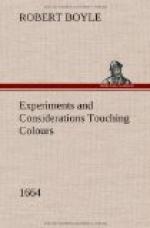Short; for after other things not needfull to be here
Transcribed:
Iter, says he,
Diurnum
duo scilicet montana milliaria (quae 12 Italica sunt)
consiciunt. Nocte vero sub splendissima luna,
duplatum iter consumunt aut triplatum. Neque
id incommode fit, cum nivium reverberatione lunaris
splendoris sublimes & declives campos illustret, ac
etiam montium praecipitia ac noxias feras a lorge prospiciant
evitandas. Which Testimony I the less Scruple
to allege, because that it agrees very well with what
has been Affirm’d to me by a Physician of
Mosco,
whom the Notion I have been Treating of concerning
Whiteness invited me to ask whether he could not See
much farther when he Travell’d by Night in
Russia
than he could do in
England, or elsewhere, when
there was no Snow upon the Ground; For this Ingenious
Person inform’d me, that he could See Things
at a farr greater Distance, and with more Clearness,
when he Travell’d by Night on the
Russian
Snow, though without the Assistance of Moon-shine,
than we in these Parts would easily be perswaded.
Though it seems not unlikely to me, that the Intenseness
of the Cold may contribute something to the considerableness
of the Effect, by much Clearing the Air of Darkish
Steams, which in these more Temperate Climates are
wont to Thicken it in Snowy weather: For having
purposely inquir’d of this Doctor, and consulted
that Ingenious Navigator Captain
James’s
Voyage hereafter to be further mention’d, I
find both their Relations agree in this, that in Dark
Frosty Nights they could Discover more Stars, and See
the rest Clearer than we in
England are wont
to do.
[8] Gent. Septen. Histor. lib.
4 cap. 13.
6. I know indeed that divers Learned Men think,
that Snow so strongly Affects our Eye, not by a Borrow’d,
but a Native Light; But I venture to give it as a
Proof, that White Bodies reflect more Light than Others,
because having once purposely plac’d a parcel
of Snow in a Room carefully Darkned, that no Celestial
Light might come to fall upon it; neither I, nor an
ingenous Person, (Skill’d in Opticks) whom I
desir’d for a Witness, could find, that it had
any other Light than what it receiv’d. And
however, ’tis usual among those that Travel
in Dark Nights, that the Guides wear something of
White to be Discern’d by, there being scarce
any Night so Dark, but that in the Free Air there
remains some Light, though Broken and Debilitated
perhaps by a thousand Reflections from the Opacous
Corpuscles that Swim in the Air, and lend it to one
another before it comes to arrive at the Eye.




